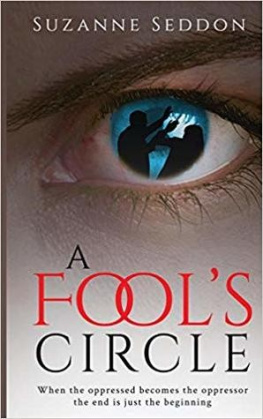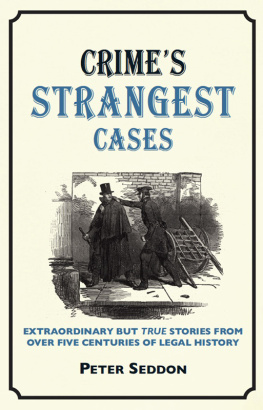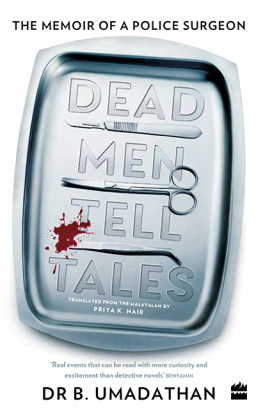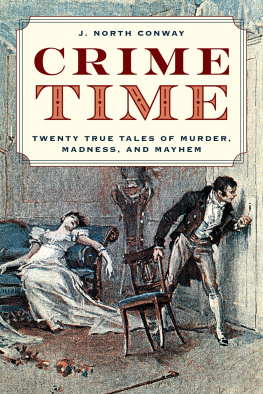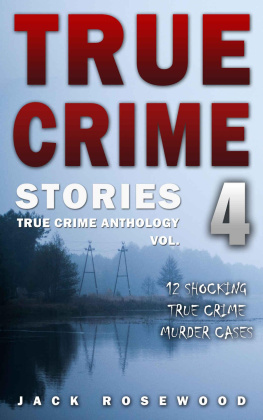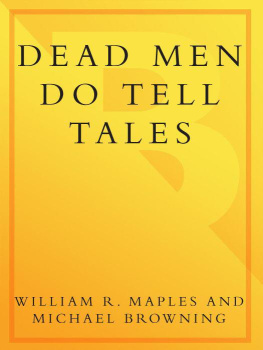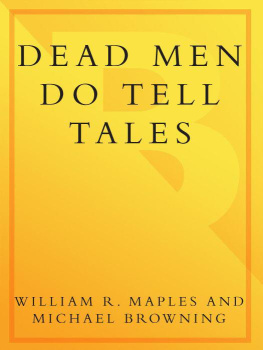
Other titles in the STRANGEST series
Crickets Strangest Matches
Footballs Strangest Matches
Golfs Strangest Rounds
Kents Strangest Tales
Londons Strangest Tales
Medicines Strangest Cases
Motor-racings Strangest Races
Rugbys Strangest Matches
Runnings Strangest Tales
Shakespeares Strangest Tales
Teachers Strangest Tales
Tenniss Strangest Matches

Extraordinary but true stories
from over five centuries of legal history
PETER SEDDON

CONTENTS
How often have I said to you that when you have eliminated the impossible, whatever remains, however improbable, must be the truth?
Sherlock Holmes, The Sign of the Four (1890)
INTRODUCTION
Few laymen would claim to be fascinated by accountancy or banking, despite their undoubted entertainment potential. Yet legal matters are altogether different, for equally few laymen would claim not to be seduced by the stories of murder, intrigue, crime, punishment and the pursuit of justice that have made The Law such a perennially popular subject, more on a par with sport and the entertainment industry than its close relations in other professions. With that in mind I put it to you that the law is theatre with a cast of thousands, a multitude of heroes and villains, improvised scripts and cliffhanger endings never revealed until the very last second of the final act.
It is for reasons of entertainment, therefore, that I offer the curious accounts in The Laws Strangest Cases, a collection of true stories that illustrate the idiosyncrasies of legal (and illegal) doings throughout centuries of history.
The choice at my disposal was mind-boggling. The easiest methodology would have been to fill the book with celebrated murder trials, but I opted instead to track down a much broader range of cases that would illustrate the many different facets of the law and the larger-than-life characters who seek either to make it or break it.
The result is a purely personal selection in which humour, oddity and the macabre loom large. There are medieval tales such as the mass trial of moles for vandalism (The Accused Have Gone to Ground) and the most outlandish admission of guilt of all time (An Imaginative Confession). There are astonishing survivals of the death penalty (Well, Ill Be Hanged!), the corpse who gave spoken evidence at his own inquest (The Eleventh Witness) and the heartening story of Capstick, the most diligent police officer of all time.
Murder inevitably rears its ugly but strangely irresistible head in a number of my selections. Trust Me, Im a Doctor would be too far-fetched even for Victorian melodrama, yet thanks to Harold Shipman, the doctor with the worst bedside manner of all time, that all-too-true account comes towards the end of the book at the dawn of the civilised twenty-first century.
Other murder cases display a more light-hearted touch. Consider the murderess who collected rent from her mummified victim for 21 years (A Very Quiet Tenant) or the wishful thinker who gave himself away by describing himself in a job application as a widower before hed bumped off his wife (A Man Ahead of His Time).
I imagined that judges might add a sober balance to such ridiculous tales as the serial cutlery-swallower (A Knife-and-Fork Job) but how wrong I was, for time and again they simply demanded inclusion for reasons every bit as bizarre. I could no more leave out the English judge whose penchant for whisky and cigarettes landed him with a smuggling conviction (One Case Too Many) than I could the Welsh judge who had his wig stolen in court (A Symbolic Crime). Barristers too have had their moments. None more so than the exasperated American who appealed for a verdict to be reversed because the opposition had broken wind throughout his closing speech (The Most Desperate Appeal Ever).
Even animals get a look-in. Not So Dumb Witness recalls Tetter the dog, who gave winning evidence at an industrial tribunal, and the most famous snail in legal history is honoured in the celebrated 1920s case which blazed a trail to the compensation culture we know today (Once Pickled, Forever Toasted).
The bulk of the cases are from Britain, with the Old Bailey figuring prominently, but I found it impossible to exclude a number from the United States and elsewhere, as strangeness is as likely to strike in Sydney and New York, or at the nether regions of Carlisle and Colchester, as at the very heart of the English legal system itself.
My sources were many and I am particularly indebted to the anonymous scribes who compiled The All England Law Reports and the many accomplished more popular writers whose published works alerted me to cases I might have otherwise overlooked.
Although I studied law as a module at university, I did not enter the profession. I have approached the subject as an experienced practitioner of strangeology, but through the eyes of a legal layman. So The Laws Strangest Cases is no dry legal textbook, but rather a sideways look at the subject from a light-hearted standpoint, although with serious overtones never far away.
I would like to thank friends and members of the legal profession for suggesting subject matter, and my editors Nicola Newman and Katie Hewett for bringing the book to fruition. Let proceedings commence.
Peter Seddon
THE STRANGEST CASE OF ALL TIME?
JERUSALEM, c.AD 33
The accused apparently died at 3p.m. on Friday, 3 April, AD 33, although strangely some say it was three years earlier. Others assert that he didnt die at all. The records are inconclusive. The method of execution was barbaric and there had been no proper trial, only a hastily convened mock court presided over by officials of varying degrees of corruption. That trial, moreover, was conducted under Jewish law within which the empowerment to pass a death sentence was questionable. The Jewish authorities overcame this trifling difficulty by trumping up suitably embellished charges and handing the prisoner over to the Roman authorities, who operated under a completely different legal code by which powers of execution were unlimited.
Yet the Roman Governor of Judea was sceptical of the charges against his newly delivered prisoner. Yes, he had entered Jerusalem during the week preceding the great festival of Passover. Yes, he had aroused great fervour among many of the 300,000 pilgrims gathered in the city. Yes, he had preached at the temple and overturned the stalls of merchants trying to conduct business around it. He was a dissident of sorts, it was true. Perhaps even a prophet, as his disciples were to claim. But was he really King of the Jews, a direct threat to Roman authority? And was he truly the son of God or just a harmless traveller with ideas beyond his station, skilled at making capital from a gullible public?
The Roman Governor was tempted to release his charge, for it was his custom to grant freedom to one prisoner during the Passover festivities. He was, too, rather afraid of the reaction of the prisoners followers if the death sentence was confirmed. He decided to pursue a novel judicial procedure, putting the vote to the gathered crowd of Jews.
He announced to the unruly throng that he found no fault with the man in his custody; but, despite his charismatic appeal in some quarters, the prisoner got the thumbs-down from the majority and was therefore sent to execution on nothing more than a public show of hands. To compound the treachery of this flagrant miscarriage of justice, another prisoner, Barabbas, a known murderer, was freed instead.
Next page

